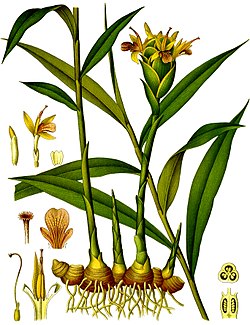| Zingiber | |
|---|---|
 | |
| Zingiber officinale 1896 illustration [1] | |
| Scientific classification | |
| Kingdom: | Plantae |
| Clade: | Tracheophytes |
| Clade: | Angiosperms |
| Clade: | Monocots |
| Clade: | Commelinids |
| Order: | Zingiberales |
| Family: | Zingiberaceae |
| Subfamily: | Zingiberoideae |
| Tribe: | Zingibereae |
| Genus: | Zingiber Mill., 1754 |
| Synonyms [2] | |
| |
Zingiber is a genus of flowering plants in the family Zingiberaceae. It is native to China, the Indian subcontinent, New Guinea, and Southeast Asia, especially Thailand. [2] [3] [4] [5] It contains the true gingers, plants grown the world over for their culinary value. The most well known species are Z. officinale and Z. mioga , two garden gingers. The genus name comes from Latin borrowing the Tamil name for the first species. [6]








